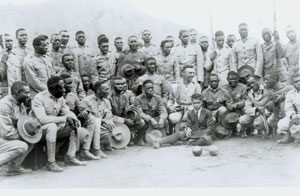Types of Materials: Surveys and Overviews
Writing about Hawai'i has been a cottage industry for Westerners since the early 19th century. Missionaries, travelers, sailors, entrepreneurs, reporters, and writers, among others, have written thousands of monographs, some attempting to recount the history of Hawai'i, many others reminiscing about a particular time and place. These documents provide a particular window on Euroamerican perceptions of Hawai'i, Hawaiians, and the history and politics of Hawai'i.

Gavan Daw's Shoal of Time and Lawrence Fuchs' Hawai'i Pono remain the two most comprehensive general overviews of Hawai'i which give significant attention to the early Territorial period. Both are now dated and Fuchs' method of documentation is frustrating to access for even the seasoned researcher. Their value lie in their attempt at an exhaustive analysis and their engagement of race and ethnicity as one of the most relevant forces in local history and politics. Fuchs and Daws have produced works which can be endlessly mined and provide a necessary entrance into some of the major social and political events of 20th century Hawai'i.

Ralph Kuykendall is still considered the preeminent historian of Hawai'i. His three-volume history, The Kingdom of Hawaii, remains the most comprehensive study of the political history of the Kingdom. Kuykendall, along with A. Grove Day, produced a one-volume history of Hawai'i from western contact to statehood. It, too, is dated and his analysis is limited, but even in one volume, Kuykendall demonstrates his mastery of facts in the history of Hawai'i. Because Asian immigrants have played so significant a role in the development and history of Hawai'i, there is a great deal of material on, by, and about Asian immigrant communities in Hawai'i. The Hawaiian collection contains bibliographies pertaining to Chinese, Japanese, Filipino, and Korean communities in Hawai'i (see "Bibliographies and Indexes.") Special mention should be made of recent studies by Gary Okihiro and Eileen Tamura. Okihiro's Cane Fires: The Anti-Japanese Movement in Hawai'i, is primarily a labor and social history focusing on the systematic discrimination and racism faced by Japanese plantation laborers. Tamura's Americanization, Acculturation, and Ethnic Identity: The Nisei Generation in Hawai'i, is also a social history focusing on the efforts to assimilate the Nisei generation through education. Other useful overviews include Noel Kent's Hawai'i: Islands Under the Influence and Edward Beechert's Working in Hawai'i. Both are labor histories and focus on the racial politics of labor organizing on sugar plantations in Hawai'i.

For the beginning researcher an overview of the history of Hawai'i is critical in order to place primary materials into a useful historical context. The following texts are illustrative of a variety of types of narrative history and highlight specific aspects of the history of Hawai'i even as they attempt to be relatively comprehensive. In this section book-length ethnic histories, political and economic histories, which shed some light on Hawai'i, are included.
Adams, Romanzo. Japanese in Hawai'i. New York: National Committee on American Japanese Relations, 1924.
Allen, Gwenfread. Hawaii's War Years, 1941-45. Honolulu: University of Hawai'i Press, 1950.
Beechert, Edward. Working in Hawaii: A Labor History. Honolulu: University of Hawai'i Press, 1985.
Brislin, Tom. "Weep into Silence/Cries of Rage: Bitter Divisions in Hawai'i's Japanese Press." Columbia, S.C.: Association for Education in Journalism and Mass Communication, 1995.
Conroy, Hilary. The Japanese Frontier in Hawai'i, 1868-1898. Berkeley: University of California Press, 1953.
Daws, Gavan. Shoal of Time: A History of the Hawaiian Islands. New York: Macmillan, 1969.
Fuchs, Lawrence. Hawaii Pono: A Social History. New York: Harcourt, Brace and World, 1968.
Glick, Clarence E. Sojourners and Settlers: Chinese Migrants in Hawai'i. Honolulu: University of Hawai'i Press, 1980.
Hawaii Newspaper Project. Hawaii Newspapers: A Union List. Sophia McMillen, cataloguer, Nancy Morris, project manager. Honolulu, 1987.
Joesting, Edward. Hawai'i: An Uncommon History. New York: W.W. Norton and Company, Inc., 1972.
Johnson, Rubellite K. Kukui 'Aha'ilono Carry on the News. Honolulu: Topgallant Pub. Co., 1976.
Kent, Noel. Hawai'i: Islands Under the Influence. Second edition. Honolulu: University of Hawai'i Press, 1993.
Kimura, Yukiko. Issei: Japanese Immigrants in Hawaii. Honolulu: University of Hawai'i Press, 1988.
Kuykendall, Ralph S. The Hawaiian Kingdom. 3 vols. Honolulu: University of Hawai'i Press. 1938-67.
Lind, Andrew. Hawaii's Japanese: An Experiment in Democracy. Princeton: Princeton University Press, 1946.
____________. An Island Community: Ecological Succession in Hawai'i. Chicago: University of Chicago Press, 1938.
Mo'okini, Esther. The Hawaiian Newspapers. Honolulu: Topgallant Pub. Co., 1974.
Okahata, James H., ed. A History of Japanese in Hawaii. Honolulu: United Japanese Society of Hawai'i, 1971.
Okihiro, Gary. Cane Fires: The Anti-Japanese Movement in Hawai'i, 1865-1945. Philadelphia: Temple University Press, 1991.
Tamura, Eileen. Americanization, Acculturation, and Ethnic Identity: The Nisei Generation in Hawai'i. Chicago: University of Illinois Press, 1994.
Wakukawa, Ernest K. A History of the Japanese People in Hawai'i. Honolulu: Toyo Shoin, 1938.
Wright, Theon. The Disenchanted Isles. New York: Dial, 1972.
